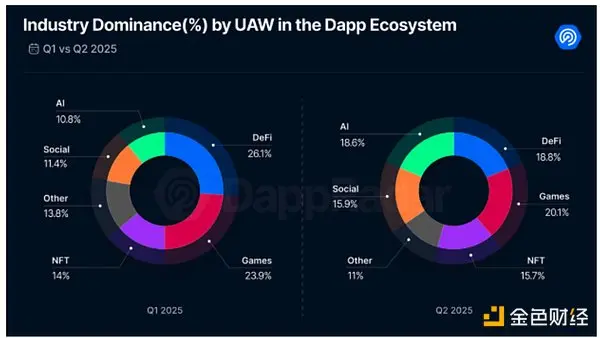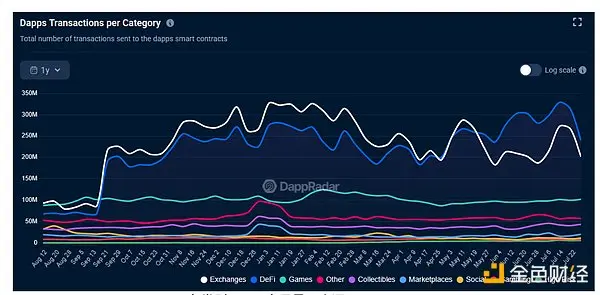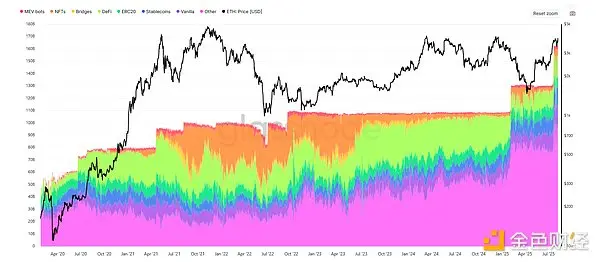Author: Marie Poteriaieva
Source: Cointelegraph
Translation: Shan Ouba, Jinse Finance
Key Points
- Daily active users in Web3: Remained at 24 million in Q2 2025, but the composition of various sectors is changing.
- DeFi: Leads with a weekly transaction volume of 240 million, but Ethereum Gas consumption is now primarily occupied by RWA, DePIN, and AI.
- Outstanding assets: Smart contract platform tokens, yield-generating DeFi, and RWA tokens outperform the market; AI and DePIN, despite strong narratives, lag behind.
Altcoins are not merely speculative targets outside of Bitcoin. In most cases, they represent or attempt to represent specific activity areas within the Web3 ecosystem, which is seen as a decentralized alternative to the traditional internet and its services.
To assess the current state and potential of the altcoin market, one cannot only look at prices. Metrics such as Gas consumption, transaction volume, and the number of unique active wallets (UAW) can measure the level of activity and adoption, while token price performance reveals whether the market is following on-chain trends.
AI and Social DApps are Gaining Widespread Adoption
UAW (Unique Active Wallets) counts the different addresses interacting with DApps, which can measure the breadth of user adoption to some extent (though it may be overestimated due to multiple wallets or automated operations).
DappRadar's Q2 2025 report shows daily wallet activity stabilizing at around 24 million. However, the dominance of sectors is changing. Crypto gaming remains the largest category, holding over 20% market share, but has declined compared to Q1. DeFi has also decreased, dropping from over 26% to less than 19%.
In contrast, social and AI-related DApps are developing. Farcaster leads in the social space with about 40,000 daily active UAWs. In the AI direction, agent-based protocols like Virtuals Protocol (VIRTUAL $1.18) are performing well, attracting about 1,900 UAWs weekly.

UAW dominates the DApp industry. Source: DappRadar
DeFi Attracts "Big Players"
The number of transactions indicates how frequently smart contracts are triggered, but it is easily influenced by bots and automation.
DeFi's transaction footprint is quite paradoxical. Although its user base has declined, it still generates over 240 million transactions weekly—more than any other Web3 category. Exchange-related activities (which may overlap with DeFi) further solidify DeFi's dominance, with crypto gaming's weekly transaction volume at 100 million, and the "other" category (excluding social but including AI) at 57 million.

Transaction volume by DApp category. Source: DappRadar
Total Value Locked (TVL) is even more compelling. According to DefiLlama, DeFi's TVL has reached $137 billion, growing 150% since January 2024, but still below the peak of $177 billion at the end of 2021.
The discrepancy between rising TVL and declining UAW reflects a key theme of this cryptocurrency cycle: institutionalization. Capital is concentrating in fewer, larger wallets, now also including funds. This trend remains in its infancy due to regulatory uncertainties facing DeFi in many jurisdictions.
Nevertheless, institutions are still testing the waters by providing liquidity to permissioned pools, lending through tokenized government bonds on platforms like Ondo Finance and Maple (SYROP), which is also known for its partnership with investment bank Cantor Fitzgerald.
Meanwhile, as DeFi gradually evolves into a capital-efficient layer focused on large-scale yield generation rather than retail participation, protocol-level automation provided by DeFi services like Lido (LIDO) or EigenLayer further suppresses wallet activity.
Other Use Cases are Dominating Ethereum's Gas Consumption
Simple transaction data cannot fully present the picture of Web3, while Ethereum's Gas usage can reveal the true distribution of economic and computational load.
Data from Glassnode shows that although DeFi has always been a core segment of Ethereum, its Gas consumption now accounts for only 11%; NFTs, which held a significant share in 2022, have now dropped to 4%.
In contrast, the "other" category's share has surged from about 25% in 2022 to over 58% today. This category encompasses areas such as Real World Asset tokenization (RWA), Decentralized Physical Infrastructure (DePIN), AI-driven DApps, and other more or less novel services, all of which have the potential to define the next phase of growth for Web3.

Ethereum Gas usage (by category). Source: Glassnode
Especially RWA, often seen as one of the most promising areas in crypto. Excluding stablecoins, its total scale has jumped from $15.8 billion at the beginning of 2024 to $25.4 billion today, involving about 346,000 token holders.
Will Prices Follow the Web3 Narrative?
Asset prices rarely align with on-chain activity. Short-term speculation can drive prices up, but sustained growth often aligns with sectors that have real utility and adoption. Over the past year, infrastructure and yield-oriented projects have significantly outperformed those driven solely by narrative.
Smart contract platform tokens have seen the strongest gains, with the top ten averaging a 142% increase, including HBAR rising by 360% and XLM by 334%. As the foundational cornerstone of Web3, the price growth of these tokens reflects investor confidence in the long-term development of the sector. DeFi tokens have also performed well, averaging a 77% year-on-year increase, with Curve DAO (CRV) up 308% and Pendle (PENDLE) up 110%.
The top ten RWA tokens averaged a 65% increase, primarily benefiting from XDC (+237%) and OUSG (+137%). Highlights in the DePIN sector include JasmyCoin (+72%) and Aethir (+39%), yet they still struggle to avoid an overall average increase lingering around 10%.
AI tokens, on the other hand, are significantly lagging: the top ten pure AI projects have dropped 25% year-on-year, with only Bittensor (TAO) rising by 34%. Most gaming tokens recorded declines, with only SuperVerse (SUPER) surging 750% over the past 12 months. As for social tokens, they remain almost absent from the crypto space, with major protocols still lacking native assets.
Overall, Web3 investment remains concentrated in mature sectors, boosting the native currencies of mainstream smart contract platforms. Yield-oriented DeFi and RWA tokens have also delivered impressive returns. In contrast, the most hyped narrative sectors like AI, DePIN, and social have yet to convert attention into actual token gains.
As adoption deepens and more sectors mature, the gap between narrative and performance may gradually narrow. But for now, investor confidence remains firmly rooted in the foundational elements of the decentralized economy.
免责声明:本文章仅代表作者个人观点,不代表本平台的立场和观点。本文章仅供信息分享,不构成对任何人的任何投资建议。用户与作者之间的任何争议,与本平台无关。如网页中刊载的文章或图片涉及侵权,请提供相关的权利证明和身份证明发送邮件到support@aicoin.com,本平台相关工作人员将会进行核查。




